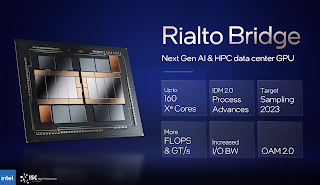Intel announced Rialto Bridge, a data center graphics processing unit (GPU) offering up to 160 Xe cores, more FLOPs, more I/O bandwidth and higher TDP limits for significantly increased density, performance and efficiency. It uses the same architecture as the Intel data center GPU Ponte Vecchio and adds enhanced tiles with Intel's next process node.
Intel said the next major architecture innovation on its roadmap will be Falcon Shores, bringing x86 CPU and Xe GPU architectures together into a single socket. This architecture is targeted for 2024 and projected to deliver benefits of more than 5x performance-per-watt, 5x compute density, 5x memory capacity and bandwidth improvements.
Jeff McVeigh, vice president and general manager of the Super Compute Group at Intel Corporation, writes:
"As the data center and HPC workloads increasingly move toward disaggregated architectures and heterogeneous computing, we will need tools that can help us effectively manage these complex and diverse computing environments."
Today, we are introducing Intel XPU Manager, an open-source solution for monitoring and managing Intel data center GPUs locally and remotely. It was designed to simplify administration, to maximize reliability and uptime by running comprehensive diagnostics, to improve utilization and to perform firmware updates."












